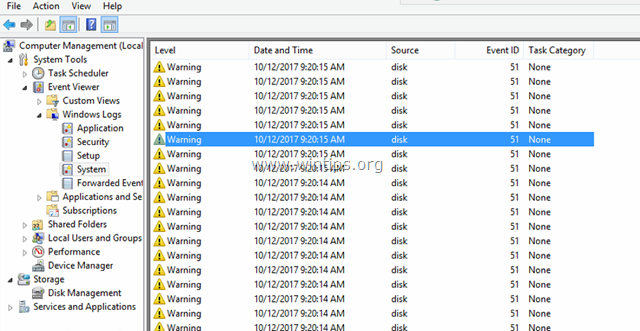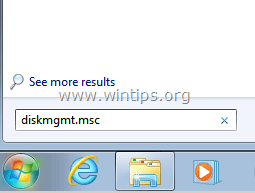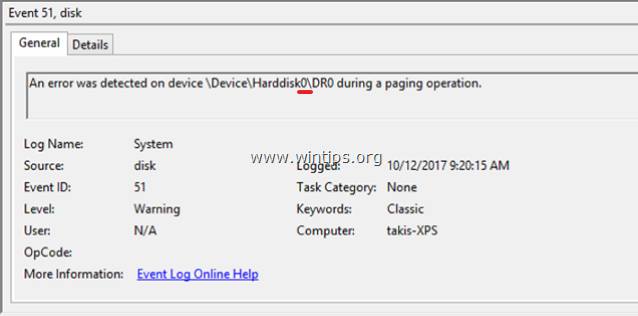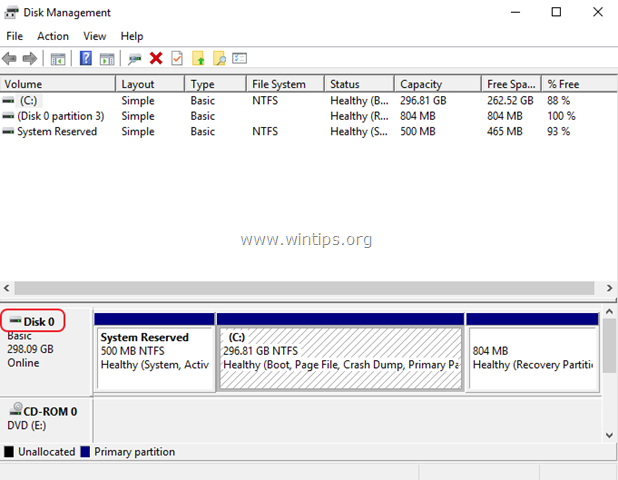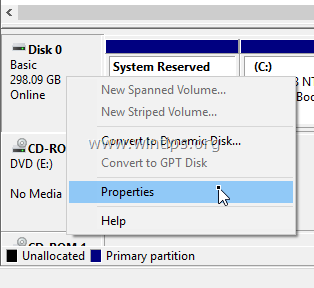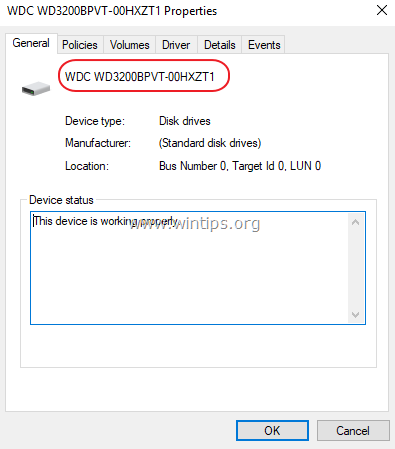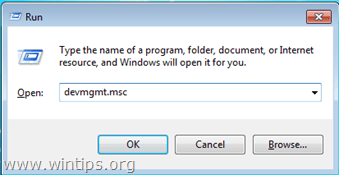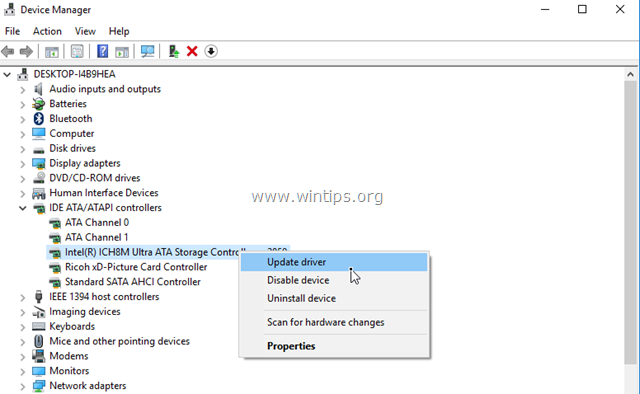Предупреждение Disk Event 51 «Обнаружена ошибка на устройстве Device Harddisk … во время операции подкачки», обычно указывает на проблему, связанную с оборудованием или драйвером устройства. Сообщение о событии с кодом события 51 регистрируется, если возникает ошибка, когда ваш компьютер перенаправляет информацию на диск или с него.
Код события 51 не обязательно означает, что ваш жесткий диск неисправен. Ошибка может возникать, когда на диске заканчивается свободное место, из-за проблемного контроллера жесткого диска, из-за поврежденного кабеля данных жесткого диска или из-за неправильного извлечения диска (например, если это внешний USB-диск или большой палец USB) диск).
В этом руководстве вы найдете подробные инструкции по устранению предупреждающего сообщения «Предупреждение о событии диска 51. Ошибка устройства на устройстве во время операции подкачки», в Windows 10, 8, 7 или Vista.
Как исправить: Событие диска 51. На жестком диске устройства обнаружена ошибка во время операции подкачки.
ВАЖНЫЙ: Перед устранением неполадок в Event ID 51 на диске, используя шаги, упомянутые ниже, убедитесь, что диск не заполнен а также РЕЗЕРВНЫЙ ваши данные. Если вы не можете прочитать содержимое диска, то:
1. Подключите жесткий диск к другому компьютеру (если есть).
2. Если у вас есть настольный компьютер, подключите жесткий диск к другому порту (например, порту SATA) на материнской плате или замените кабель жесткого диска.
3. Если у вас есть портативный компьютер, отсоедините жесткий диск от его кабеля и подключите его снова или замените его.
4. Если вы получили сообщение об ошибке Event ID 51 на внешнем USB-диске, то, вероятно, ошибка вызвана тем, что диск был удален из системы без использования опции «Безопасное удаление USB». В этом случае проверьте диск на наличие ошибок с помощью команды «CHKDSK» (см. Инструкции в шаге 3 ниже). Если после запуска CHKDSK ошибка не устранена, подключите диск к другому USB-порту или, если можете, извлеките диск из его корпуса и подключите его непосредственно к вашей системе.
Шаг 1. Найдите, на каком диске отображается ошибка «Event ID 51».
Продолжите и выясните, на каком физическом диске ссылается ошибка 51, используя Управление дисками. *
* Заметка: Если в вашей системе установлен только один жесткий диск, пропустите этот шаг и перейдите к шагу 2.
1. Одновременно нажмите Ключ Windows + р открыть окно запуска команды.
2. Внутри окна поиска (запуска) введите: diskmgmt.msc и нажмите Войти.
3. В Управление диском Окно идентифицирует, какой диск, по номеру «жесткого диска», указанному в событии с идентификатором 51.
Для примера:
а. Как видно на приведенном ниже снимке экрана, предупреждающее сообщение о событии 51 относится к устройству «Жесткий диск».0Msgstr «В этом случае Событие 51 указывает на Диск 0.
«Событие 51, диск — Обнаружена ошибка на устройстве Устройство Жесткий диск0 DR0, во время пейджинговой операции «
б. Таким образом, в данном случае Событие 51 указывает на Диск 0.
4. Затем щелкните правой кнопкой мыши на проблемном диске и выберите свойства.
5. В генеральный На вкладке вы увидите модель диска.
6. Используя эту информацию, продолжайте и найдите, на каком физическом диске возникла проблема.
Шаг 2. Обновите драйверы устройств контроллера жесткого диска.
Следующим шагом для устранения ошибки 51 является обновление драйверов для контроллера жесткого диска. Для этого:
- Нажмите «Windows»
+ «р«ключи для загрузки Бег чат.
- Тип devmgmt.msc и нажмите Войти.
2. В диспетчере устройств двойной щелчок расширять ‘Контроллеры IDE ATA / ATAPI». *
3. Щелкните правой кнопкой мыши на контроллерах хранилища (по одному) и выберите Обновить драйвер.
* Заметки:
1. Если Windows не может найти обновленный драйвер, перейдите на сайт поддержки производителя, найдите обновленный драйвер набора микросхем и установите все другие рекомендуемые драйверы для контроллеров хранилища.
2. Если проблемным диском является USB-диск, разверните и обновите драйверы универсальных контроллеров последовательной шины.
3. Если проблемный диск — SCSI или IEEE 1394 (Firewire), установите обновленный драйвер для контроллера SCSI или IEEE 1394.
Шаг 3. Проверьте и исправьте ошибки файловой системы с помощью CHKDSK.
Следующим шагом является проверка жесткого диска на наличие проблем с помощью команды CHKDSK. Для этого:
1. Открыть Командная строка от имени администратора.
2. В окне командной строки введите следующую команду * и нажмите Войти:
- chkdsk X: / F / R
* Замените букву «X» в приведенной выше команде в соответствии с буквой диска проблемного диска.
3. После завершения операции команды CHKDSK перезагрузите систему и проверьте, сохраняется ли предупреждающее сообщение Event ID 51 в средстве просмотра системных событий.
Другие способы разрешения диска с предупреждением ID 51:
1. Удалите Intel Storage Manager (если установлен).
2. Измените режим SATA с AHCI на IDE в настройках BIOS. *
* Примечание. В некоторых случаях при переходе с SATA на AHCI (или наоборот) Windows может не загружаться. Если это произойдет, верните настройки режима SATA обратно в режим AHCI.
3. Замените блок питания (блок питания), если у вас есть настольный компьютер.
4. Протестируйте и диагностируйте жесткий диск на предмет аппаратных проблем.
Это оно! Дайте мне знать, если это руководство помогло вам, оставив свой комментарий о вашем опыте. Пожалуйста, любите и делитесь этим руководством, чтобы помочь другим.
- Remove From My Forums
-
Вопрос
-
Всем привет! помогите решить проблему:
Error: (04/01/2018 02:28:35 PM) (Source: Disk) (EventID: 11) (User: )
Description: Драйвер обнаружил ошибку контроллера \Device\Harddisk2\DR2.Error: (04/01/2018 02:28:33 PM) (Source: Disk) (EventID: 11) (User: )
Description: Драйвер обнаружил ошибку контроллера \Device\Harddisk2\DR2.Error: (04/01/2018 02:11:07 PM) (Source: DCOM) (EventID: 10016) (User: NT AUTHORITY)
Description: Параметры разрешений для конкретного приложения не дают разрешения Локально Активация для приложения COM-сервера с CLSID
{D63B10C5-BB46-4990-A94F-E40B9D520160}
и APPID
{9CA88EE3-ACB7-47C8-AFC4-AB702511C276}
пользователю NT AUTHORITY\LOCAL SERVICE с ИД безопасности (S-1-5-19) и адресом LocalHost (с использованием LRPC), выполняемого в
контейнере приложения Недоступно с ИД безопасности (Недоступно). Это разрешение безопасности можно изменить с помощью средства администрирования служб компонентов.Error: (04/01/2018 01:59:18 PM) (Source: DCOM) (EventID: 10016) (User: NT AUTHORITY)
Description: Параметры разрешений для конкретного приложения не дают разрешения Локально Активация для приложения COM-сервера с CLSID
{D63B10C5-BB46-4990-A94F-E40B9D520160}
и APPID
{9CA88EE3-ACB7-47C8-AFC4-AB702511C276}
пользователю NT AUTHORITY\LOCAL SERVICE с ИД безопасности (S-1-5-19) и адресом LocalHost (с использованием LRPC), выполняемого в
контейнере приложения Недоступно с ИД безопасности (Недоступно). Это разрешение безопасности можно изменить с помощью средства администрирования служб компонентов.Error: (04/01/2018 01:58:51 PM) (Source: DCOM) (EventID: 10010) (User: DESKTOP-1PLTASR)
Description: Регистрация сервера {373E19B5-76AA-46D5-93A9-2E39A99B39B2} DCOM не выполнена за отведенное время ожидания.Error: (04/01/2018 01:58:01 PM) (Source: DCOM) (EventID: 10016) (User: DESKTOP-1PLTASR)
Description: Параметры разрешений для конкретного приложения не дают разрешения Локально Активация для приложения COM-сервера с CLSID
{D63B10C5-BB46-4990-A94F-E40B9D520160}
и APPID
{9CA88EE3-ACB7-47C8-AFC4-AB702511C276}
пользователю DESKTOP-1PLTASR\DELL с ИД безопасности (S-1-5-21-3606941575-3582918554-1347771739-1001) и адресом LocalHost (с использованием
LRPC), выполняемого в контейнере приложения Недоступно с ИД безопасности (Недоступно). Это разрешение безопасности можно изменить с помощью средства администрирования служб компонентов.Error: (04/01/2018 01:57:31 PM) (Source: Disk) (EventID: 11) (User: )
Description: Драйвер обнаружил ошибку контроллера \Device\Harddisk2\DR2.Error: (04/01/2018 01:57:29 PM) (Source: Disk) (EventID: 11) (User: )
Description: Драйвер обнаружил ошибку контроллера \Device\Harddisk2\DR2.пробовал программу что пару постов выше WinObj , но ничего подобного не могу найти как Harddisk2\DR2…
подключал сейчас 2 внешних харда и 2 сд карты, везде пишет Harddisk2, но DR0 или 1 или 3 и т.д. до 6 , но с цифрой 2 ничего нету. никак не разберусь, из за этой
проблемы ни могу больше обновлять Windows, писал об этом тутhttps://social.technet.microsoft.com/Forums/ru-RU/a4a7de83-7b6b-402a-ac25-e40f7d808e9f/-080070bc2?forum=win10itprogeneralRU
Ответы
-
Кто объяснит, какие проблемы между WIN10 и ESET Endpoint Security??
Я вспомнил, что как в том году после обновления пропал интернет, хотя значок сети горел, а браузер все писал, что мол инета нету. Где то прочитал, что проблема может быть в ESETe, снес его и о чудо связь появилась, снова установил
ESET и все работало и дальше и обновлялось, до этого момента.Сейчас я опять снес ESET и все обновы встали без проблем!!! Даже WIN10 до версии 1803 обновился!!! Установил опять внтивир и все работает дальше…
Почему такие проблемы с ESET или с другими антивирами тож такое бывает??
ЗЫ. в итоге так и не понял прикола с Драйвер обнаружил ошибку контроллера !?!?!?!?
-
Изменено
1 мая 2018 г. 14:17
-
Предложено в качестве ответа
Vector BCOModerator
1 мая 2018 г. 14:27 -
Помечено в качестве ответа
Vector BCOModerator
1 мая 2018 г. 14:27 -
Изменено
SQxModerator
1 мая 2018 г. 16:08
уменьшил шрифт
-
Изменено
- Remove From My Forums

2012 R2 Hyper-V VM Disk 2 has been surprise removed | An error was detected on device \Device\Harddisk2\DR2 during a paging operation
-
Question
-
I have been scouring the internet for over a week now, and I cannot figure this one out. Some background… I am retiring an old physical file share server, and I am creating a new 2012 R2 VM on a 2012R2 DataCenter Core Hyper-V host. Creating the VM
went without issue. It is configured as follows:8GB RAM
4 CPU Cores
72GB system drive (C:\)
2TB data drive (D:\)
12GB page file drive (Z:\)
I have about 1.8TB of data to copy over from a physical box, so I am using RoboCopy. I have gotten about 1.5TB of data over, then the new VM’s data drive (D:\) disappears and the copy fails. The disk no longer appears in Windows Explorer or diskmgmt.msc.
The even log shows many event IDs 153 (The IO operation at logical block address 0x*** for Disk 2 was retried) and event IDs 51 (An error was detected on device \Device\Harddisk2\DR2 during a paging operation, and the last event when the drive disappears is
a single Event ID 157 (Disk 2 has been surprise removed).After racking my head over this for several days, I deleted the VHDX for the 2TB data drive, created a new one, and started the data copy all over… same issue. I completely deleted the VM and all files, reinstalled on new VHDX drives… same issue.
This leads me to think it is an issue with the Hyper-V host, but there are no event IDs pertaining to this, and the other 53VMs are running without issue.
I would SINCERELY appreciate any help with this.
Sorry for huge post, but thank you in advance!
-
Edited by
Tuesday, July 22, 2014 3:30 PM
-
Edited by
27.08.2015, 20:56. Показов 8680. Ответов 6
Метки нет (Все метки)

Принесли ноут, всё как всегда, винду поставить)
7ка ставится, всё ок, после установки сначала вылез чёрный экран и сообщение о ошибке на харде, и мол исправляем(пакеты какие-то перебирал, или что-то такое, не знаю как грамотно сказать).
После запускается винда(ставил с флешки, с неё вчера на другой ноут всё встало), и ошибка device\Harddisk2\DR2, говорит вставьте диск.
Что делать?
после ещё раз ставил винду с другого источника, итог тот-же
0
Posted by derektom 2013-02-19T14:39:22Z
Am seeing the following in my 2008R2 Event Viewer:
* Event Time: 19 Feb 2013 02:42:19 AM
* Source: Disk
* Event Log: System
* Type: Error
* Event ID: 11
* Event User: N/A
* The driver detected a controller error on \Device\Harddisk2\DR2.
On this server I have internal RAID volumes, an external iSCSI drive (DroboPro), and several USB 2.0 hard drives attached. How can I determine what hard drive / storage device is «\Device\Harddisk2\DR2»?
Thanks in advance for any feedback.
Cheers,
Derek
30 Replies
-
click start, right click computer and select manage. Expand storage on the left and select disk management. That should tell you.
Was this post helpful?
thumb_up
thumb_down
-
Thanks for your reply. That’s the first place I looked but I’m unsure how to correlate Harddisk2\DR2 to any of those drives. Is «DR2» = «Disk 2»? Attached is a screenshot for reference. Thanks again.
attach_file
Attachment
drives.jpg
304 KB
Was this post helpful?
thumb_up
thumb_down
-
Rockn
This person is a verified professional.
Verify your account
to enable IT peers to see that you are a professional.mace
Does diskpart give you more detailed info?
Was this post helpful?
thumb_up
thumb_down
-
Do you have any Management software installed for the RAID? That would have it’s own logging and hopefully diagnostics too.
Was this post helpful?
thumb_up
thumb_down
-
-
Thanks for the feedback, Rockn, LarryG., and Fishsauce.
diskpart didn’t give me any helpful info beyond what the Disk Management console had already provided.
I have HP RAID management software but it didn’t really help either since I have so many other hard drives (USB, iSCSI) that are not on the internal RAID.
Following a link off of the link Fishsauce provided (below), it does seem to validate that the disk in question is «Disk 2» that in Disk Management shows is an external 2TB USB Seagate GoFlex drive.
http://support.microsoft.com/kb/159865 Opens a new window
NOTE: Disk Management is enhanced in Windows 2000 and later operating systems. You can use Disk Management to view this information without using Registry Editor. To view where a particular hard disk is located in your system, use the following procedure:
-
Start Disk Management console (diskmgmt.msc).
-
View the graphical view of your disks. Right-click the gray portion of the basic or dynamic disk whose disk number matches the "Harddisk#" in the error message.
-
Click Properties. The Properties will contain "Device Type" information that will tell you if the disk is IDE or SCSI, and it will also display the "Hardware Vendor" name of the physical device and the "Adapter Name" it is attached to.
I’ll swap out that drive and see if the error goes away.
Was this post helpful?
thumb_up
thumb_down
-
-
Any update on this? I am curios as I am having the same event log error generated.
Was this post helpful?
thumb_up
thumb_down
-
Ha!.. Sorry for not following up on this…
YES, I swapped out the «Disk 2» drive (an external Seagate GoFlex) as indicated in the Disk Management console and the errors went away.
So the disk numbers shown in the Disk Management console (Disk 1, Disk 2, Disk 3, etc) correspond to the \Device\Harddisk# in those Event Log errors. For instance, in the following error, the matching disk to look for in Disk Management is «Disk 5».
The driver detected a controller error on \Device\Harddisk5\DR6
Was this post helpful?
thumb_up
thumb_down
-
Note that I made a correction in the above post.
Was this post helpful?
thumb_up
thumb_down
-
I hadn’t realized that your post was from May, but here is some info in case other run into this:
I would take a look at «WinObj» from the Sysinternals, it’s a free download:
http:/ Opens a new window
/ technet.microsoft.com/ en-us/ sysinternals/ bb896657.aspx Fire that up and expand the «Device» tree node. Under there you will have several nodes for «Harddisk0» … that should help.
I was under the impression that «DR» stands for «disk removable», but I honestly wasn’t able to find any references to that so I could be wrong. But in my experience this error is almost always logged for USB drives (and we see a lot of events since we do event log monitoring).
One thing to note however, is that «DR» is being incremented as you insert new (e.g. USB) drives. So, if you insert a memory stick for the first time, it could be logged as
Harddisk1\DR1
but when you eject it and put it back in, it will be
Harddisk1\DR2
So you definitely can’t go by the DR unless you use Winobj. The «Harddisk5» should refer to «Disk 5» in Disk Management however.
Hope this helps.
Was this post helpful?
thumb_up
thumb_down
-
Hi Ingmar, much thanks for that additional info. Good stuff!
Was this post helpful?
thumb_up
thumb_down
-
As far as I remember, DR represents the Raw physical drive and DP represents Disk Partition.
Every disk will have a device controlling the Raw Physical drive (DR identifier) and a device per each partition, controlling the partition (DP instance)
For example: Harddisk1\DR2 and Harddisk1\DP3
Unlike in the case of Harddisk#, the numbers after DR and DP are not counters. These are just unique random numbers.
I assume that the DR number is somehow linked to drive signatures. Same drive inserted multiple times into the same port will have same DR. Another drive inserted to the same port will have a different DR. But this is just an assumption. Maybe DR changes with each insertion/removal even if the drive is the same. I haven’t tried this.
I use DISKPART:
CMD >
DISKPART
list disk
Was this post helpful?
thumb_up
thumb_down
-
I just read all of the answers, even trying WinObj, but I still do not know what physical drive is associated with the error message in the event viewer.
Device\Harddisk1
Why doesn’t MS have a clear answer for this?
Was this post helpful?
thumb_up
thumb_down
-
Slacka…when you are in Disk Management and you are looking at the the graphical view of the disks, right click on the first drive and select Properties. From there select the Volumes tab and next the word Disk, which should be the first line item, you will see which actual disk that is. Let me know if this helps.
Was this post helpful?
thumb_up
thumb_down
-
I am having this occur regularly on six disk (3 out of 4 disks in 2 different mediasonic hf2-su3s2 proboxs) I am using StableBit Scanner to monitor the disk and it isn’t reporting any issues. The computer is running Windows Server 2012 R2 Essentials and the two externals enclosures are connected by USB 3.0 (which has been its own headache with the disks constantly dropping out all the time but I finally fixed that issue with a Anker USB 3.0 hub (no clue why that fixed it but glad that it did) It usually occurs six instances in a row disk 6 disk 7 disk 8 disk 8 disk 7 disk 6 and then same thing with 10, 11, 12, 12, 11, 10. Could this be an issue with the enclosures and not the drives maybe a problem with the port multiplier and that is why it is only 3 out of the four disks. Neither of the first disk in the enclosure get the error (disk 5, or 9)
Was this post helpful?
thumb_up
thumb_down
-
Well what about..
An error was detected on device \Device\Harddisk1\DR25
When I go to Disk management..all I have is «Disk 0»
So does harddisk1 = disk 0
and harddisk2 = disk 1
??????
Was this post helpful?
thumb_up
thumb_down
-
josephboombox — do you have a DVD/CD drive? If you have only one drive and it’s showing as Disk 0 in Disk Management, but you also have a CD-ROM 0 next to it, the CD-ROM may be detected as Disk 1. That is my experience with Windows and this message. For example, I have the following configuration in Disk Management: Disk 0 (RAID — C), Disk 1 (RAID- D), Disk 2 (USB — E), CD-ROM 0 (CD-ROM): , however, in DISKPART is shows this: Volume 0 — DVD-ROM, Volume 1 — C:, Volume 2 — D, Volume 3 — E. In other words, Windows moved DVD-ROM in front of the other drives and shifted the numbers by 1. Hope that makes sense. And the numbers that are shown in DISKPART seem to be corresponding to the ones in the error message. Thank you Microsoft for not making our job easy.
Was this post helpful?
thumb_up
thumb_down
-
Hola, estoy leyendolos y a mi me aparece este error No hay disco en la unidad. Inserte un disco en la unidad /device/Harddisk5/DRS, ALGUNO DE UDS SABRIA DARME UNA ORIENTACION A KE SE DEBE Y COMO RESOLVERLO,? PORK YO NI IDEA !!!!!! MUCHAS GRACIAS.
Was this post helpful?
thumb_up
thumb_down
-
God damn it I am fed up with this! I have had this question myself for YEARS! Here is another question Why the god damn bloody hell does MS make this information so F’ing hard to correlate to a physical drive?
Why not have an app where you can simply see each \device id that corresponds to each bloody disk!!!!!! Disk 1 -> \device\harddisk#\DR# or something?
It’s crap like this that makes me truly hate windows! It’s like they go out of their way to make stuff totally incomprehensible! What are they trying to force everyone to take the MCSE course to learn the SECRET HANDSHAKE?
I mean what if my car speedometer gave me my speed in furlongs per fortnight then converted that to a secret guid so my speedometer reads your speed is … {000f-2343-aff1-0034……}?
Or better yet replace everything on my dashboard with a single red light and when it comes on SOMETHING is broke! Don’t give me a clue or way to find out what is broke just tell me something is broke or even worse give me this tantalizing string that looks like it can be simply decoded to point to a specific thing when in fact it cannot be and there might be one guy in the universe that knows how to decode it!
WHY ENCODE IT IN THE FIRST PLACE????
I mean seriously google «what drive is \device\harddisk1\DR1» and you will get a bazillion responses just like this one with 400 responses — none of which answer the question! It’s a simple god damn question and the answer should be like one line. Run xxx and it will translate every physical drive you can see to a \device id. Or run xxx and enter the \device string and it will spit out the physical drive in a human readable format!
No instead we get things like look at the hex dump from the event message and take the entry at 0001 03 now convert that number and divide it by your weight in grams then if it’s a Monday or any month with an A in the name mulriply that by your mother birth date converted to gregian date converted to the integer number of days since the epoc raised to the log of 3……ARGH!!!!!!
1 found this helpful
thumb_up
thumb_down
-
Thank you rm9 for your eloquent and educated reply.
The most prominent omission from your valuable contribution is the Microsoft troubleshooter. I would be grateful to know if ANYONE has ever had any joy from running the Microsoft Troubleshooter or from the «Search online for a solution to this problem» option?
I’d really also be interested to know if Microsoft ever actually does anything with the billions of error reports that are automatically sent to them.
Otherwise I can only second and applaud your comments….
Was this post helpful?
thumb_up
thumb_down
-
here is the problem with the Microsoft paradigm. they have a group of really really bright folks working on part of this whole disk drive management issue. and, they also have another group of really really bright folks working on another aspect of the disk drive management issue.
here is the kicker: neither one of these groups communicates with the other. so we have this elaborate schema describing the disk structures, and we also have a second similarly elaborate schema describing the SAME structure. however, there is no common description and there is no map or description of the correlation between these two schema.
my perception is that this has been a long term failure in the management of the Microsoft development process, or to phrase it another way, nobody has a clue WTF is going on overall. nobody grasps the big picture concept. maintenance efforts suffer while troops in the field try to decipher this hodgepodge of disparately presented information about the same subject. recollect the elephant? very much like a tree, or wait, like a snake… no it’s a wall!
luls. yeah, i’m here because i have the same problem. just WHICH darn drive is the dud?
Was this post helpful?
thumb_up
thumb_down
-
i had same trouble,shown device/harddisc2/dr2
after i instaling an application.it sucks.
i was re instaling windows,still shown.
how to fix it?
0 of 1 found this helpful
thumb_up
thumb_down
-
This link might help.
http://support.microsoft.com/kb/159865 Opens a new window
How to Distinguish a Physical Disk Device from an Event Message Opens a new window
start button,
right click on my computer >
select manage
select storage from the left tree menu
this will list all the attached drives.
all HDD will be number as DISK 0, DISK 1, DISK2 etc.from the error message ‘device/Harddisc2/DR2’ the Harddisc2 corresponds to DISK2 attached to your computer/server
however, DR2 in the error message, i think it corresponds to the desk sector number 2 or partition number 2.
1 of 2 found this helpful
thumb_up
thumb_down
-
mr9: I feel your pain. But I think you forgot to divide by pi. Or maybe multiply by pi. And then go have a pint.
So far, for me, Hardisk3, or whatever number, has matched up with the graphical display of the Disk # in Disk Management. And it’s usually been the external USB backup disks. But one time it was one of the 4 disks in a RAID 10. Boy was that fun!
Was this post helpful?
thumb_up
thumb_down
-
I managed to find the device using WinObj as guided in http://wp.me/p1KeqG-6F Opens a new window%uFEFF
Was this post helpful?
thumb_up
thumb_down
-
CirruSafe is an IT service provider.
pimiento
I have Intel® Server System R2308SC2SHFN with embedded RAID controller. Two RAID arrays. No removable drives. Drive Group 0 and Drive Group 1 are RAID 5. Intel RAID Web Console says both arrays are healthy.
Windows Management console — Disk Management says RAID drive group 0 is Disk 0 and RAID drive group 1 is Disk 1.
Windows Event viewer says errors are occurring on \Device\Harddisk2\DR76 and \Device\Harddisk3\DR77.
So, at least in this case, the disk number in the logs (Harddisk2 and Harddisk3) and the disk number in Disk Management (0 and1) have nothing to do with each other.
RAID group 0 has three partitions (System Reserved, C:, and E:) and RAID group 1 gas one partition (F:).
So maybe each partition corresponds to a «Harddisk» number?
Anyone have any experienewith Intel’s embedded RAID controller?
Was this post helpful?
thumb_up
thumb_down
-
Desktop-Host wrote:
Anyone have any experienewith Intel’s embedded RAID controller?
Please create a new thread with your questions.
Was this post helpful?
thumb_up
thumb_down
-
CirruSafe is an IT service provider.
pimiento
Done on Windows Server
Was this post helpful?
thumb_up
thumb_down
-
Don’t think so. The disks are enumerated starting at zero. So Disk 2 is really the third disk. Yes what you say would make sense, but when I get a message that identifies \Device\Harddisk4\DR6 when I don’t have a Disk 4 and I certainly don’t have 6 partitions. I suspect that your answer is probably not correct. Do I have a better one? No. Wish I did, because I’d really like to know which disk to swap out before it goes completely under.
Was this post helpful?
thumb_up
thumb_down
-
I laughed so hard I think I hurt a stomach muscle now. I couldn’t agree more with rm9 and pdoff!
Was this post helpful?
thumb_up
thumb_down
Read these next…
Beginner to RDP needs some basic pointers
Windows
HI, I am not new to IT at all, but have never set up an RDP server before today. I need to allow a user to connect in to a desktop session.What I have managed so far is install Remote Desktop Services on a Windows 2022 server, including a client access l…
Your thoughts on Surface Pro devices?
Hardware
Personally, I hate them. They’re terrible, little confined pieces of cr*p that overheat so easily, a nightmare to image unless you buy a dock for it. The only people i’ve seen who actually praise them are managers and directors since it makes them look be…
Snap! — Space Submarines, Brain Waves, Chernobyl Wind Farm, Real-Life Asteroids
Spiceworks Originals
Your daily dose of tech news, in brief.
Welcome to the Snap!
Flashback: September 21, 1996: Programming Error May Have Contributed to Plane Crash (Read more HERE.)
Bonus Flashback: September 21, 2003: Galileo Completes Jupiter Mission (Re…
Large amount of spam recently getting around filters. How to stop these?
Security
Got a HUGE uptick in spam emails recently, and they are actually getting through. The spam is coming from gibberish@gibberish.onmicrosoft.com and coming from IPs 40.107.X.X which after a quick search is Microsoft IPs…I am not able to just filter the do…
Old invoicing / tracking software
Software
Hi wonderful people. I hope someone may be able to assist with a rather perplexing issue.We started working with a company a few years ago providing their IT support.They use a very old (20 years plus) software package which they had built from scratch. …

